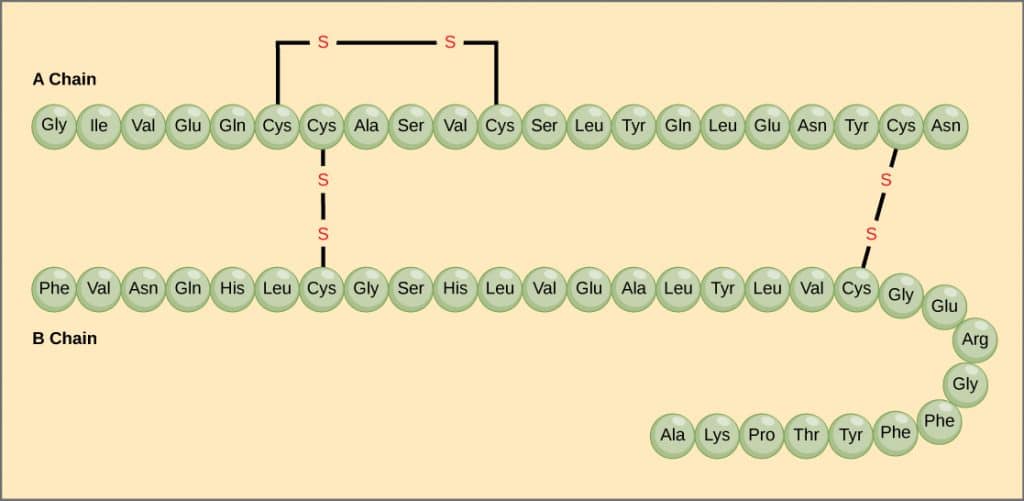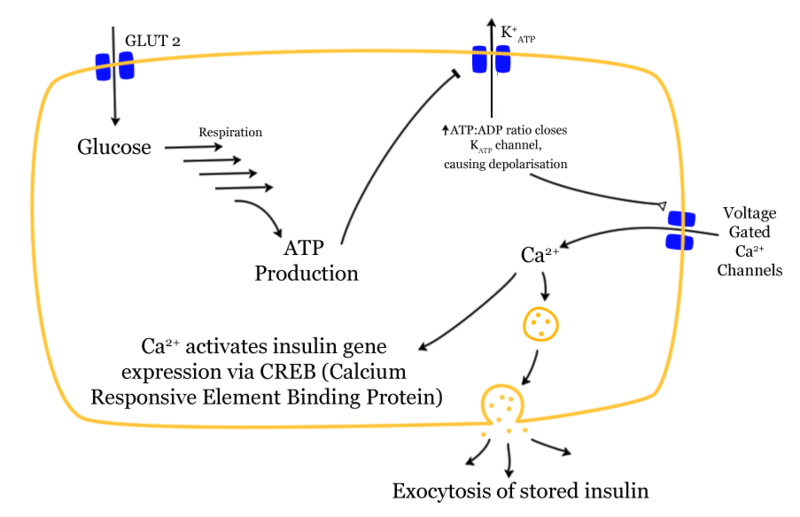Insulin is a peptide hormone produced by beta cells within the pancreas. It is responsible for regulating the movement of glucose from the blood into cells. It is released in an endocrine fashion into the bloodstream.
This article will consider the structure of insulin, how it is synthesised and secreted, its actions on the body as well as the clinical conditions that are associated with faults in its production.
Structure
Insulin consists of two polypeptide chains, an A chain and a B chain, covalently linked by two inter-chain disulfide bridges. There is a third, intra-chain disulfide bridge.
Synthesis
Insulin is synthesised in the beta cells of the islets of Langerhans. Firstly, the insulin mRNA is translated as a single chain precursor called preproinsulin. There is then removal of its signal peptide at the N-terminus during insertion at the endoplasmic reticulum. This generates proinsulin.
In the endoplasmic reticulum, endopeptidases excise a connecting peptide (c-peptide) between the A and B chains. This breaks the single-chain into two strands (A and B) that are held together by disulfide bridges – i.e. this generates the mature form of insulin.
Equimolar amounts of insulin and free c-peptide are packaged in the golgi apparatus into storage vesicles which accumulate in the cytoplasm.
Secretion
A rise in glucose levels in extra-cellular fluid (ECF) is the stimulus for insulin release.
Glucose is transported into the beta cell by facilitated diffusion through GLUT2 channels. Therefore, a rise in glucose concentration in the ECF causes a rise in glucose concentration in beta cells. This leads to membrane depolarisation of ATP-sensitive K+ channels, opening Ca2+ channels, triggering an influx of calcium.
An increase in intracellular Ca2+ triggers insulin release by a two stage process:
- Margination – the process by which insulin storage vesicles move to the cell surface
- Exocytosis – fusion of the vesicle membrane with the plasma membrane, with release of the vesicle’s entire contents
Secretion of insulin follows a biphasic pattern – i.e. occurs in two phases:
- Pulsatile release (rapid onset) – short-term blood glucose control: clearing absorbed nutrients from the blood following a meal.
- Protracted release (longer) – long-term insulin release for glucose uptake e.g. for cell growth, cell division, stimulating protein synthesis and DNA replication.
Mechanism of Action
Insulin binds to a highly specific insulin receptor on cell surfaces.
The receptor is a dimer – 2 identical sub-units spanning the cell membrane. The 2 subunits are made of:
- One alpha chain (on the exterior of the cell membrane)
- One beta chain (spans cell membrane in a single segment)
These are connected by a single disulfide bond.
When insulin is detected, the alpha chains move together and fold around the insulin. This moves the beta chains together making them an active tyrosine kinase. This initiates a phosphorylation cascade which results in an increase of GLUT4 expression – a protein channel to allow glucose uptake. The result is an increase of glucose uptake by cells.
Overall Effects
Overall, insulin can be considered the “anabolic” or building hormone – it assists processes that build compounds for storage and decrease processes that break down those storage reserves.
- In muscle and liver, insulin increases glycogenesis and decreases glycogenolysis.
- Decreased gluconeogenesis in the liver
- Increased glycolysis in liver and adipose tissue.
- Decreased breakdown of amino acids in the liver.
- Increased amino acid uptake and protein synthesis in muscle, liver, and adipose tissue.
- Decreased lipolysis
- Increased lipogenesis and esterification of fatty acids in the liver and adipose tissue.
Control of Insulin
| Stimulates insulin secretion | Inhibits insulin secretion |
| GI tract hormones | Adrenaline |
| Acetylcholine | Noradrenaline |
Clinical Relevance – Type 2 Diabetes Mellitus
Type 2 diabetes mellitus involves a dual pathology: there is insulin resistance, i.e. there is normal insulin secretion but tissue become insensitive, losing their receptiveness to insulin.
In a compensatory effort, beta cells work harder to produce insulin. This cannot be sustained and eventually, there is also relative insulin deficiency in type 2 diabetes mellitus.
This can present with the classic triad of symptoms; polyuria, polydipsia, and weight loss, although it is likely to be less noticeable than those with type 1 diabetes as it is a more gradual process.
It is an important diagnosis as it can lead to macrovascular complications such as strokes and heart attacks. Therefore, early recognition and treatment are vital to reduce these serious complications.
The first intervention should always be lifestyle modifications, such as diet changes and an increase in exercise. Next, metformin is the mainstay of initial pharmacological intervention. If hyperglycemia is still present, a range of pharmacological managements can be trialled, such as SGLT2 inhibitors.


